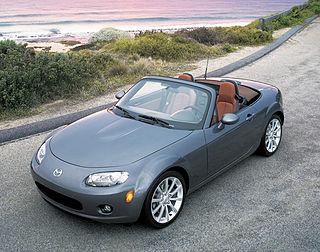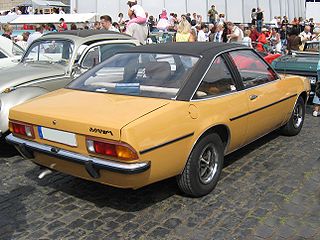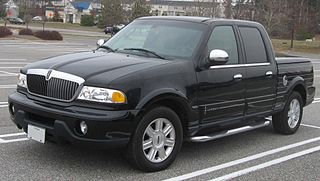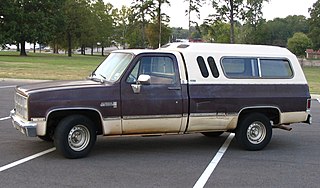
A hearse is a large vehicle, originally a horse carriage but later with the introduction of motor vehicles, a car, used to carry the body of a deceased person in a coffin at a funeral, wake, or memorial service. They range from deliberately anonymous vehicles to heavily decorated vehicles.

The Cadillac Motor Car Division is a division of the American automobile manufacturer General Motors (GM) that designs and builds luxury vehicles. Its major markets are the United States, Canada and China. Cadillac models are distributed in 34 additional markets worldwide. Historically, Cadillac automobiles were at the top of the luxury field within the United States, but have been outsold by European luxury brands including BMW and Mercedes since the 2000s. In 2019, Cadillac sold 390,458 vehicles worldwide, a record for the brand.

A convertible or cabriolet is a passenger car that can be driven with or without a roof in place. The methods of retracting and storing the roof vary among eras and manufacturers.
Governments and private organizations have developed car classification schemes that are used for various purposes including regulation, description, and categorization of cars.

The Lincoln Town Car is a model line of full-size luxury sedans that was marketed by the Lincoln division of the American automaker Ford Motor Company. Deriving its name from a limousine body style, Lincoln marketed the Town Car from 1981 to 2011, with the nameplate previously serving as the flagship trim of the Lincoln Continental. Produced across three generations for thirty model years, the Town Car was marketed directly against luxury sedans from Cadillac and Chrysler.
There are many types of car body styles. They vary depending on intended use, market position, location, and the era they were made.

Vinyl roof refers to a vinyl covering for an automobile's top.

The first call vehicle is a vehicle used in the funeral service industry. This type of vehicle is used to pick up the remains of a recently deceased person, and transport that person to the funeral home for preparation. This initial pickup is called the "first call", hence the name of these vehicles. While some funeral homes will use their hearse for these initial pickups, having vehicles specifically for first calls and using the hearse solely for funerals reduces wear on hearses and makes the first call process more discreet. Sometimes, when the procession portion of funeral protocol comes into play, First Call vehicles double as funeral yield vehicles, which grants the procession the right of way.

The Lincoln Blackwood is a luxury pickup truck that was marketed by the Lincoln division of Ford Motor Company for the 2002 model year. The first pickup truck marketed by Lincoln, the Blackwood was derived from the Ford F-150 SuperCrew and the Lincoln Navigator. Drawing its name from its simulated black woodgrain cargo box, the Blackwood was offered solely with a black-painted exterior.

The Cadillac Commercial Chassis is a chassis that was built by the Cadillac division of General Motors. Produced from 1931 to 1979, the Commercial Chassis was constructed as an incomplete vehicle intended for use by coachbuilders for final assembly and fitment of bodywork. Produced on the D platform throughout its entire production, the Commercial Chassis was initially derived from the Series 355, shifting to the Series 75 from 1936 onward.

The Ectomobile is a fictional vehicle from the Ghostbusters franchise. It appears in the films Ghostbusters (1984), Ghostbusters II (1989), the reboot, where in it appears as a hearse as opposed to the original's ambulance, Ghostbusters (2016), Ghostbusters: Afterlife (2021), Ghostbusters: Frozen Empire (2024), in the animated television series: The Real Ghostbusters, Slimer! and Extreme Ghostbusters, and in the video games Ghostbusters: The Video Game and Beeline's Ghostbusters iOS app.

A camper shell is a small housing or rigid canopy used as a pickup truck or coupe utility accessory. The housing is usually made of fiberglass or aluminum, but sometimes wood or canvas, and is mounted atop the pickup truck's rear bed. It usually covers the entire bed of the pickup truck, and is large enough to be used for camping purposes, thus making the vehicle an RV. The top of the camper shell is usually even with or above the top of the truck cab. Even though use for camping may have been its initial purpose, it now seems most often to be used for utility and storage purposes – particularly the protection of cargo from the elements and theft.

A tonneau, bed or tray is an area of a car or truck open at the top. It can be for passengers or cargo.
A professional car is loosely defined as a vehicle based on a special long wheelbase commercial chassis and sometimes, though rarely, on modified passenger car chassis, for use as a hearse, flower car, service car, ambulance, limousines or for a combination of purposes. The term is mostly used in the United States.
A pimpmobile is a large luxury vehicle, usually a 1960s, 1970s or 1980s-model Lincoln, Cadillac, Buick or Chrysler vehicle, that has been customized in a garish, extravagant and kitsch or campy style. The style is largely an American phenomenon.

The first Cadillac automobiles were the 1903 Model built in the last quarter of 1902. These were 2-seater "horseless carriages" powered by a reliable and sturdy 10 hp (7 kW) single-cylinder engine developed by Alanson Partridge Brush and built by Leland and Faulconer Manufacturing Company of Detroit, of which Henry Leland was founder, vice-president and general manager.

The Cadillac V8, introduced as the Type 51, is a large, luxurious automobile that was introduced in September 1914 by Cadillac as a 1915 model. It was Cadillac's first V8 automobile, replacing the four-cylinder Model 30, and used the all new GM A platform for the entire series shared with all GM division brands using a 122 in (3,099 mm) wheelbase, while a 145 in (3,683 mm) chassis was offered separately to be used for custom coachwork. The Types 53, 55, 57, 59, and 61 were introduced every year through 1923 with yearly improvements until an all new platform was substantially updated and introduced as the V-63 using the business philosophy called planned obsolescence. It was built at the Cass Street and Amsterdam Avenue factory in Detroit, with the coachwork provided by Fisher Body. The chassis could be purchased separately and sent to the clients choice of coachbuilder optionally.

The Cadillac V-63 is a large luxury automobile that was introduced in September 1923 by Cadillac as a 1924 model, replacing the previous Type 61. It used the GM C platform and was replaced by the Cadillac Series 355 in 1931. It retained the name Cadillac V8 introduced with the previous generation Cadillac Type 51.

A horse-drawn vehicle is a piece of equipment pulled by one or more horses. These vehicles typically have two or four wheels and were used to carry passengers or a load. They were once common worldwide, but they have mostly been replaced by automobiles and other forms of self-propelled transport but are still in use today.

The Cadillac Series 355 was a V8-powered luxury car manufactured by Cadillac from 1931 until 1935. It was offered as a 2-door club coupe, 2-door convertible, 4-door convertible, 4-door sedan, 4-door town car, and 4-door limousine. It provided a range of Cadillac below the maker's larger V-12 and V-16 lines. It was succeeded by the Cadillac Series 70/75.
















